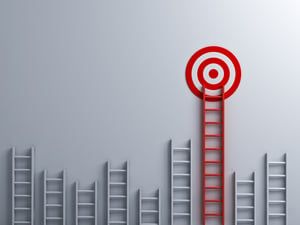
Very few people have the luxury of being a totally free spirit… although wouldn’t that be fun? Most of us need structure and planning to get through the day—and to be able to (hopefully) cross a ton of stuff off the always-growing to-do list.
In marketing, building structure and strategy isn’t a fully linear process (as much as we’d like that to be true). Things come up that force reassessment, redirection. That said, there are key steps that can help make creating strategy a more efficient and effective exercise.
One Foot in Front of the Other
Any good strategy first starts with a goal to ladder up to, and then each rung of that ladder plots against customer journey. For example, let's say you're currently clocking 25 leads a month. Your goal is 50 leads a month, so you hire an agency to generate leads.
Things come up that force reassessment, redirection.
But first we have to step back and determine what defines a lead. Some would qualify a lead as a blog subscription, while others desire something a bit more concrete like filling out a form to receive a digital asset or a demo.
Then we have to decide what channel (or channels) you will use to attract leads, as well as what tactics you will employ. A paid ad? An email marketing campaign? Paid social? That's where budget and flighting becomes a consideration. You generally want to have some solid results in six months’ time, so if you want leads to jump 100 percent, you have to expect to spend an amount of money that will allow you to meet that goal.
Who is Your BEST Buyer?
The second part of this is gaining a clear understanding of your buyer and their journey, which helps map who you are talking to, what point in the buying process they are currently at, and the message you choose to use with that person. Starting with well-defined buyer personas is necessary to help stimulate conversation about how your customers may become aware of your product or service.
The more specific and detailed you can get with your audience, the better—for your budget, your marketing plan, and your overall success. It’s important not to limit personas to demographics or transactional data. Rather, dig into a buyer’s psychographics (tendencies, interests, lifestyle patterns) to understand their buying behaviors and what makes them your best buyer.The more specific and detailed you can get with your audience, the better.
I’ve found it helps to draw out their journey, from the time they become aware of your brand to ultimately being your biggest cheerleader. How do they come in contact with you? What do you provide, from a sales and marketing perspective, that makes them move forward? If that’s “more information,” perhaps you do some keyword research and select a set of keywords to write helpful blog content around.
You also have to be cognizant that there are often layers within the purchasing “entity.” For instance, an end-user might care more about user experience or user interface, so you may decide to discuss with that person the easy navigation of your product. However, that person's boss, the person who writes the check, might be more attracted to a discount on a bulk order.
Less Anxiety, More Clarity
As I discussed in last week’s blog, creating strategy sometimes incites anxiety—simply due to all the moving parts. While this step-by-step process isn’t something that can be written in stone, it may serve as a guide you can refer to in order to ease some of that anxiety and provide clearer direction.








